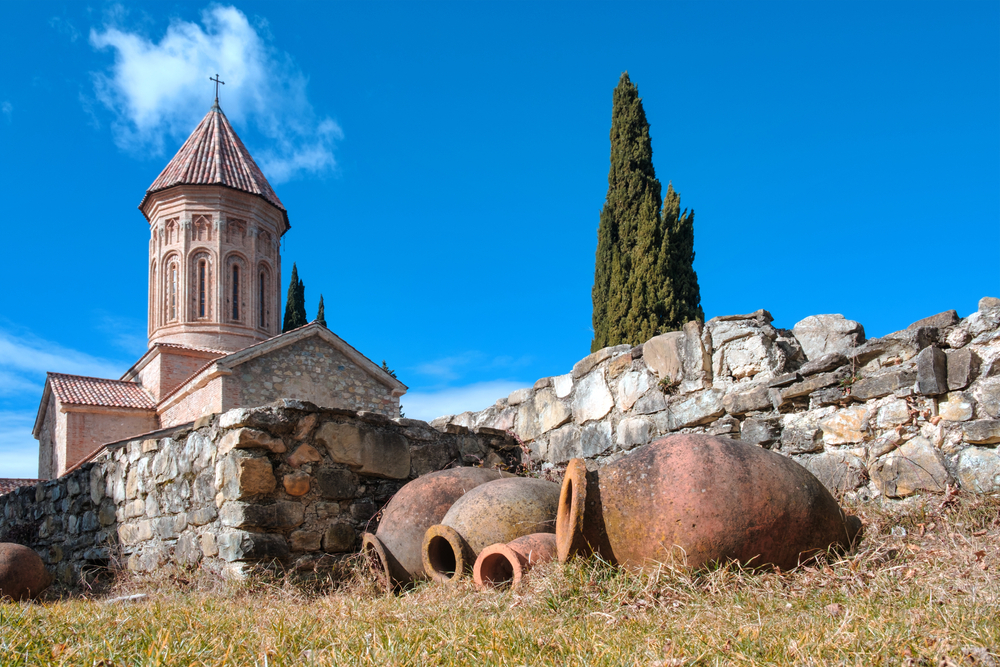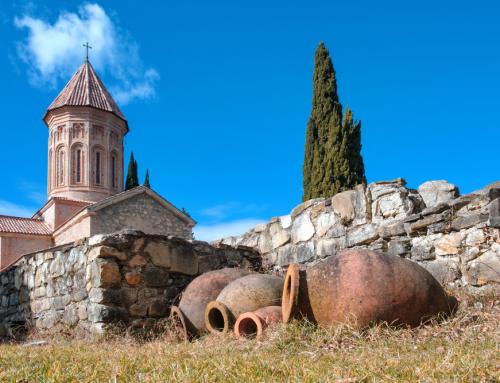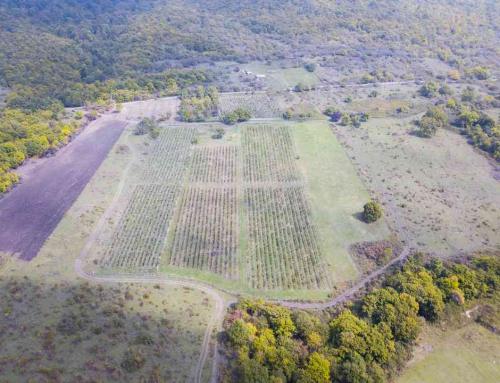“Traditional” Georgian Winemaking
When white wine is described as produced in the “traditional Georgian manner” or “pursuant to Georgian traditional methods” (as opposed to the “European method,”), it means that the wine is made in a conical clay vessel known as a qvevri . Specifically, the wine undergoes both an extended fermentation and maturation in qvevri. If fully made according to the old tradition, whole bunches of grapes (with stalks) are run into a satsnakheli, a wooden trough, typically carved a single piece of wood. The grapes are foot-trod, so as not to damage the pips, then the must is run off directly into qvevri. After pressing, the “chacha” (skins, pips, and stalks) are added to the qvevri for the alcoholic fermentation, which may last any 20-40 days, depending on the variety and the quality of the vintage. Once the fermentation is completed and the cap starts to sink, the filled qvevri will be capped with stone or glass lids for the malolactic fermentation; the lids are then sealed hermetically with limestone clay or earth, and left in the ground until spring (typically late March or early April). Then the wine is separated the chacha and run off into another qvevri for another year of aging. The process is similar for red grapes, but the period of skin maceration is shorter: usually one month, rather than four to six. Qvevri-produced wines have a firm tannic texture across the palate; whites develop aromas of apricots, orange peel, and nuts; the reds become slightly meatier, with a chalkier texture. This extended maceration through the spring is also known as eastern, or Kakhetian-style winemaking, as it is associated with Kakheti, the eastern province and source of 70% of all Georgian wine. Imeretian-style winemaking, nodding to the western province, also uses the clay vessel – here called a churi – for both red and white grapes, but the maceration period is limited to roughly one month for both red and white varieties. This style of winemaking originated in the western part of Georgia.
Qvevri
Qvevri are the clay vessels used for making wines according to the traditional Georgian winemaking method. In western Georgia they are called churi. The earliest qvevri known to store wine date the early Iron Age (7th Century B.C.E.). It took some time for the qvevri to reach their current, standard shape, as initially they were wide in the middle and tapered at the base, and not buried. The shape of the “modern” vessel continued to evolve the 3rd century B.C.E., when producers began to bury them in the earth, first to their shoulders, and by the 4th century C.E., up to the neck. Modern qvevri range 800 to 3500 liters; the smaller ones are used for fermentation, the larger, for elevage. The clay qvevri are lined once before use with melted beeswax to render the interior inert, and to make them easier to clean. In 2013 UNESCO registered the Qvevri winemaking method on its List of the Intangible Cultural Heritage of Humanity. Archeological excavations in western Georgia, notably in the ancient Imeretian town of Vani (6th -1st Century B.C.E), have unearthed ancient qvevri among numerous other wine-related artifacts. The exact origin of the qvevri/churi is unknown, but it is the centerpiece to all of Georgian winemaking historically. Through the ages up until today, all home winemakers in Georgia have made wine in qvevri. During the 20th century, commercial use of qvevri declined as winemaking in this manner is quite labor intensive; they were viewed as inefficient. Today, however, a renewed interest in qvevri has revived this method of production, not just in Georgia, but around the world.
Kakheti
The rugged province of Kakheti is Georgian wine’s center of gravity. It produces 68% of the country’s wine by volume and 75% of grapes grown for wine production. Divided into sub-appellations, it is home to 14 of the 18 Protected Designations of Origin (PDOs), production rules are stricter than for wines grown else. The main growing area straddles both sides of the Alazani River, and hence is called the Alazani Valley. The areas further north benefit their closer proximity to the main Caucasus Mountain Range and the cool breezes that flow south. It is drier than the west, benefits irrigation, and is less affected by the Black Sea. Soils are dominantly alluvial clay and loam, with calcareous subsoils, but outcrops of slate and schist characterize specific individual PDOs and villages. While the majority of wines are now produced with modern, European production methods, Kakheti has its own, distinctive tradition of qvevri production. Key regions and PDOs include Tsinandali, Mukuzani, Napareuli, Kardenakhi, Kindzmarauli.
NB: each region should be produced in hypertext to link to its own entry, it will be fleshed out in greater detail. Others also will be added. The same follows for specific wine styles (eg Pirosmani) and areas that may not yet be PDOs.
Georgian Grape Varieties
The Georgian names for their indigenous grape varieties often make specific reference to its origin or some distinguishing characteristic. While Georgia is home to at least 525 distinct grape varieties (Ketskhoveli et al. 1960), the collectivization of agriculture during the Stalinist regime, and later, Gorbachev’s anti-alcohol campaign in the 1980s led to the grubbing up of vast swaths of these indigenous varieties. Today, while only about 45 are in current commercial production, the Georgian government is engaged in concerted efforts to increase the genetic diversity within the country’s vineyards. Apart academic work to grow and study many now-obscure varieties, in 2014 the government has launched a program to encourage and support the planting of more of the diminishing varieties. In summer 2014, the National Wine Agency distributed 7000 plants to various growers, with plans for this to increase to 70,000 vine plants.
WHITE GRAPES
Rkatsiteli
Rkatsiteli, whose name means “red stem” (rka=vine cane; tsiteli=red) is the leading white grape variety in Georgia, comprising 43% of all vineyard plantings across 20,000 hectares. The time of its origin is uncertain, but is native to Kakheti in eastern Georgia and is cultivated throughout the province, as well as in Kartli. Rkatsiteli is favored by growers because it is less finicky as to site, and can achieve relatively high sugars while retaining its acidity; contemporary bottlings easily can have 13% alcohol by volume. It is arguably most expressive when grown on the northwestern part of the Alazani Valley in the Akhmeta-Ikalto zone, in the villages of Kondoli, Tsinandali, Kisiskhevi, Vazisubani and Mukuzani. Rkatsiteli’s cylindrical, medium-sized bunches contain medium-sized, oval berries; when dry-farmed, the grapes acquire a pinkish-yellow hue. Late-budding (the end of April) and late-maturing (early October, after Mtsvane Kakhuri), for vitis vinifera, Rkatsiteli is relatively resistant to downy mildew when grown in Kakheti; it is less resistant in the western, more humid regions. A hardy vine, it can withstand most winter frosts. Rkatsiteli is produced through both traditional and European vinification methods, and is the principal grape in most Kakhetian white wines. Because Rkatsiteli has relatively quiet aromatics, is is often blended with 15-20 percent Mtsvane Kakhuri, such as for the PDOs Gurjaani, Tsinandali, and Vazisubani to add high-toned aromatics and to soften the resulting wine. When vinified in the European style, Rkatsiteli offers subtle floral aromas with notes of citrus, quince, and apple. If vinified in qvevri, the wine typically is more powerful, moderately tannic, with crisp acidity; the oxidative handling elicits flavors of honey, dried orange peel, spices, apricot and other stone fruits. Rkatsiteli is predominantly vinified in a dry style, but it is also a core grape variety in the PDO Kardenakhi, a fortified wine, and is suitable for all styles of wine. Georgians also serve Rkatsiteli as a table grape. As of 2014, there are over 20,000 hectares of Rkatsiteli planted in Georgia.
Mtsvane Kakhuri
Literally, “green Kakheti,” and commonly referred to simply as “Mtsvane,” Mtsvane Kakhuri is one of six different Mtsvane variations that grow throughout Georgia, each with a different DNA fingerprint, and each named for the origin of its growth. Thought to be older than Rkatsiteli, Mtsvane Kakhuri’s five-lobed leaves are dark green and funneled; the medium-sized bunches can be quite dense, sometimes with one shoulder and medium-sized berries. The variety buds late, usually in late April and matures in the mid-season, in the last two weeks of September, before Rkatsiteli. It is an easy bunch to pick. It accumulates sugar easily yet retains high acidity levels, hence its suitability for sweet, fortified wines. Yields are generous, though the vine is very susceptible to powdery mildew, and is regarded as sensitive to its environment, demanding attentive cultivation. It is, however, relatively impervious to winter frosts. Mtsvane Kakhuri grows well on the calcareous soils in Kakheti, southeastern Georgia, particularly in the appellations of Tsinandali, Manavi, Gurdjaani, Vazisubani and Kardenakhi. When vinified in a European style, the young dry, white wine often has a greenish- straw tinge. Mtsvane Kakhuri imparts fresh white peach, floral, citrus and tropical aromas, with a light mineral undertone. It is quite dark and will show more apricot and stone fruit character when vinified in qvevri. An aromatic variety, it oxidizes easily, and unless vinified in qvevri, it requires sensitive anaerobic handling. Alternatively, it may be blended with a percentage of Kisi or Rkatsiteli; Mtsvane Kakhuri adds aromatic high tones and complexity, the other varieties inhibit oxidation. Mtsvane Kakhuri is a solo performer in the PDO Manavi, a dry white wine the region of the same name in Kakheti. Up to 20% of Mtsvane Kakhuri may be blended with Rkatsiteli for the classic Tsinandali PDO. Mtsvane Kakhuri also may have a small part in fortified wines such as Kardenakhi. It is also suitable as a table grape. There were 249 hectares planted as of 2004.
Goruli Mtsvane
Not to be confused with the Mtsvane Kakheti, this “Green Gori” has a variety of alternative names and synonyms. Commercially, however, it is labelled consistently as Goruli Mtsvane. The variety is mostly planted in the alluvial soils along the Mtkvari River including the Ateni Valley. Apart its several synonyms, Goruli Mtsvane is also exhibits considerable intra-variety variability; some can be low-yielding but suffer poor flowering or berry drop, especially if the weather is unstable. A relatively vigorous vine, bud-burst occurs in mid- to late-April and ripens in middle to late September (though harvest can be delayed if the weather is inclement). Thick-skinned, the berry is yellow-green and medium-sized. The bunches are cone-shaped and winged. Goruli Mtsvane is relatively resistant to downy mildew with average frost resistance. A variety with delicate high-toned aromatics, it oxidizes easily, and is often blended with Rkatsiteli or Chinuri to bolster its structure and inhibit oxidation. One of Georgia’s lighter-bodied wines, Goruli Mtsvane is best drunk when young and fresh, when its floral, lime, and subtle honeyed notes are crisp and most vibrant. Goruli Mtsvane is also blended with Chinuri and Budeshuri Tetri for sparkling wines, most notably the PDO Atenuri. Goruli Mtsvane, fermented with the white Chinuri and red Tavkveri in qvevri, produces the classic red Khidistauri (i.e. the town of Khidistavi near Gori). Goruli Mtsvane may also be blended with Chinuri alone for sparkling wines. There were 224 hectares in production as of the last census in 2004, though there have been additional plantings since that time.
Chinuri
Iv. Javakhishvili, an early 20th Century historian, argued that Chinuri’s name derives the old Georgian word “chini” (reddish-green), but commentators now contend it comes the Georgian word “chinebuli” meaning “excellent” or “the best” in this instance referring to the grapes superb appearance, color, and flavor. Indeed, some producers even call the variety “Chinebuli.” Regardless, when ripe, the grapes do blush a red-yellow-green. Originating in Kartli, but also grown in Kakheti, Chinuri has a three-lobed leaf; its cylindrical bunches often have one very large wing. The vine is comparatively resistant to fungal diseases (especially powdery mildew) and chlorosis, and is less susceptible to frost than many other indigenous varieties. Not being particularly fussy as to site, it grows well diverse soils and locations, whether in alluvial or stony soils, on steep slopes or the plains. It is high yielding and a medium-late ripener, with budburst in mid-April and maturation in early October. The skin detaches very easily its juicy flesh. With its naturally high acidity, Chinuri is most famous for the sparkling PDO Atenuri wine, which may include Goruli Mtsvane or Aligoté in the assemblage. Harvested a week or two later, Chinuri also is made as a still wine, with moderate alcohol levels and crisp acidity, whether fermented in qvevri or tank. When produced anaerobically (in sparkling wines or European-style still wines), Chinuri has floral and herbal aromas, including hints of mint, pear and other yellow fruits. Chinuri qvevri is tannic and muskier, with flavors of dried pears and apricots laced with a slightly more concentrated herbal complexity. The grapes alone also graces many tables in season. There were 955 hectares in production as of 2004.
Khikhvi
The origins of Khikhvi’s name are unknown and not hypothesized, but it grows widely in eastern Georgia, especially in Kakheti it originated. Most plantings are on the East-Southeast reaches of the province, on the right bank of the Alazani River. The vine sports large leaves, which are three-lobed, circular and almost round. Its medium-sized bunches are conical, winged, and somewhat loose, with medium-sized, greenish-yellow, thin-skinned berries. Budburst occurs in the first half of April and matures in September. An early ripener, it is recommended for higher-altitude, cooler mountain plantings. Along with Mtsvane Kakhuri , Khikhvi is the other Georgian variety most susceptible to powdery mildew, though it is resistant to spider mites. Khikhvi is relatively versatile, as it can be produced in light dry, semi-sweet, sweet, and, as in PDO Kardenakhi, fortified styles. Its aromatic signature is distinctive: floral notes of boxwood and wild flowers heighten broader flavors of ripe yellow fruits and apricot. The light wines appear both in European and qvevri versions; the latter wines accentuate the dried fruit and flower character. With moderate alcohol levels and soft acidity, Khikhvi may stand alone as a single varietal wine, or may contribute high-tones to enhance a blend. It is a grape that deserves greater attention. Khikhvi also grows in Kartli. Nationwide, there was only one hectare in production in Georgia as of 2004. Kisi Kisi is indigenous to Kakheti. Notwithstanding the high quality of wine it can produce, it became almost extinct by the 2000, a result of the Soviet preference for Rkatsiteli and the decline of Georgian vineyard land following the Soviet collapse. Further, it is bit trickier to grow. Fortunately, some 50-60 year old vines still exist in the Telavi district, with more being planted. A late-budding variety, Kisi is relatively resistant to frost, drought and downy mildew, but susceptible to powdery mildew and black rot. It ripens before Rkatsiteli, typically in the last 2 weeks of September, and is made both in the European and Georgian manner. Occasionally it is fortified. A straw-colored wine when produced in the European style, the nose is quite floral with flavors of pear, citrus and green tea on the palate; the amber qvevri wines reveal more apricot, mango, lime, orange and walnut character. Some producers believe it to be capable of producing finer, more expressive wines than Rkatsiteli. There were 20 hectares planted as of 2004, all on family farms, of which 18 lie in the Akhmeta district of Kakheti. Earlier commentators believed Kisi to be a younger variety than Rkatsiteli, but in fact the evidence to support this is insufficient. Krakhuna Meaning “crispy” in a local Imeretian dialect, Krakhuna is indigenous to Imereti in western Georgia. It mostly is grown in the central part of the province, around Sviri, Obcha and Dimi. Its bunches are of medium size, dense and conical, with thin-skinned berries. Depending on the meteorological conditions of its site, Krakhuna tends to bud mid-season, and ripens later (late September in Imereti). It grows well on various types of soils, produces moderate to high yields, and accumulates sugar easily while retaining its acidity. It can be a challenge to grow, given the relatively humid climate in the West and the grape’s thin skin. Thus, it is particularly susceptible to disease, especially oidium. For vitis vinifera, Krakhuna is relatively resistant to downy mildew. It may be blended with Tsolikouri and Tsitska for the Gelati blend. Whether Krakhuna is fermented either in the European and traditional Georgian manner, it offers notes of intensely ripe banana and apricots, with honeyed tones. Produced in qvevri, Krakhuna wines are deep amber, with chalky tannins, stone fruit flavors with tropical notes and a slight herbal tinge. With its considerable flavor profile and broad structure, Krakhuna wines have the potential to develop in bottle. Georgians also serve Krakhuna as a table grape. There 36 were hectares in production as of 2004. Tsitska Grown throughout upper and central Imereti, Tsitska means “variety with small grapes the village of Tsitske or Tstiskiuri.” (Iv. Javakhishvili ). By current standards, however, the grape is of medium size, with thick skins. The medium-sized, generally conical bunches tend to be compact and dense. Budburst is generally mid-April, with ripening at the beginning of October. The vine has moderate vigor but with high yields. It is rather susceptible to oidium and plasmopara viticola, the pathogen of downy mildew. When vinified to dryness, Tsitska wines suggest yellow fruits such as quince, melon, and pear, sometimes with a honeyed note. Tsitska may be blended with Tsolikouri, and sometimes Krakhuna, for PDO Sviri and other dry table wines. Tsitska grapes with 19.0-21% sugar content and 7-9g/l total acidity are regarded as best for table wine. But when cultivated for its naturally high acidity to range 9-12 g/l at harvest, it also is vinified for sparkling wine. Tsitska represented six percent of all grapes planted in Georgia in 2004, or 2839 hectares. Tsolikouri The leading white grape of western Georgia, Tsolikouri originates in Kolkheti (ancient Colchis, the land of the Golden Fleece). The origins of its name remain debated and uncertain. The vine has medium-sized, conical bunches, which may have wings, and is of average density. The round, yellow-green berry itself is relatively thick-skinned, and thus is resistant to the primary fungal diseases, making it suitable for the more humid climate in western Georgia. It is not, however, frost resistant. A late bloomer (late May) and generous yielder, Tsolikouri matures in the mid-season, usually in the middle of October. Most Tsolikouri plantings are in Imereti and Guria, but it is also planted in Racha-Lechkhumi, Samegrelo, and Adjara.) When made in the European style, Tsolikouri wines are medium- to full-bodied, slightly oily, with soft acidity and a broad texture, with subtle notes of yellow fruits, melon, mineral, and a light floral lift It may be fermented and/or matured in oak. Tsolikouri may be blended with the lighter-bodied Tsitska, and sometimes Krakhuna, for PDO Sviri wines. In PDO Tvishi, a semi-sweet wine Lechkhumi with 30-40g/l residual sugar, Tsolikouri is a solo act. Tsolikouri wines have the potential for considerable longevity if properly crafted. With 15% of total plantings there were 6161 hectares in production as of 2004.
RED GRAPES
Saperavi
Saperavi, meaning “something to color with,” or “to dye,” is Georgia’s leading red grape variety. A very old variety, it is Georgia’s most widely planted red grape, with 10% of all plantings throughout the country (over 4000 ha). Saperavi can be dry, semi-sweet, full-on sweet, or fortified. Both traditional and European methods are used, and it may be aged in French, American, Slavonian, Russian, or Hungarian oak. Regardless of how produced, this tenturier variety gives wines that are inky, often fully opaque, with aromas of dark berries, licorice, grilled meat, tobacco, chocolate and spices. Texturally, the wine is sappy and tannic, with considerable acidity; alcohol levels can range 12-14%. The aromas are terroir-sensitive: cooler regions with cool mountain breeze influence, red berries dominate the fruit character and the wines show more elegance; warmer regions, with darker soils, further the mountains, have more black fruit and meaty notes, with higher alcohol levels. The diversity of clones and varities of Saperavi attests to the ancient nature of the grape. Ampelographers studying Saperavi over 150 years have discussed at least 17 variations and clones. Many have colorful, evocative names (e.g. Saperavi Budeshuriseburi, lit. “Saperavi with prolonged berries.” In 2012 N. Tsertsvadze alone lists 7 seven different variations of this version and, characterizes S. Budeshuriseburi as a mutant of Saperavi.) Typically the variants were interplanted in small numbers with common, Kakhetian Saperavi. Leading PDOs based on Saperavi include Napareuli (dry), Mukuzani (dry, often with riper, more intense flavors); and Kindzmarauli (semi-sweet, but with crisp, fresh acidity). The area of Akhasheni, in Kakheti, has a decent concentration of older vines that can produce complex, dynamic and age-worthy expressions of Saperavi. When vinified dry, concentrated, serious efforts merit extended (10-year+) aging. Semi-sweet wines such as PDO Kindzmarauli and PDO Akhasheni are intended for early enjoyment, usually within 1-2 years of bottling. According to the 2004 census, there were 3704 hectares of Saperavi vineyards in Georgia.
Tavkveri
This red grape, evocatively named “hammerhead,” for the flat top of the berry itself, is indigenous to Kartli but also grown in Kakheti. Tavkveri grows well in deep clay and sandy soils. Its flowers are completely functionally female and therefore must be planted nearby other varieties such as Chinuri or Goruli Mtsvane to ensure pollination. Tavkveri can bud the end of March through middle April, and matures any the end of August through the middle of September. A vigorous vine and high yielding, its bunches are big and compact with broad shoulders; the grapes are round, somewhat large, and dark blue. Tavkveri is highly susceptible to the downy mildew pathogen, European grapevine moths, and spider mites. In rainy autumns, grey mold is a serious threat. Tavkveri is produced both in modern and qvevri styles; modern production may include time in oak barrels. A reasonably versatile variety, it can be an attractive, middle-weight dry red, rosé, sparkling, fortified or dessert wine. Regardless of the wine style, the attractive variety exhibits bright cherry and herbal flavors buttressed with darker, earthy flavors. Tavkveri is also enjoyed as a table grape. There were 29 hectares planted as of 2004.
Shavkapito
Meaning “vine with a black cane,” Shavkapito originated in Kartli, in eastern Georgia. Its medium-sized, conical bunches typically have wings and moderate density. The round, medium-sized berries are round and dark blue. Shavkapito tends toward a bud-burst in the last third of April and ripens in the second third of September (mid-season). It has average susceptibility to most pests or diseases, and is a moderate to high-moderate yielder. Shavkapito is rather terroir-reflective, as grapes grown on the valley floor will produce relatively full-bodied wines; wines the slopes will be lighter and softer, as those mountain and mountain foothills are light and fresh with delicate aromatics. Typicially, Shavkapito wines are of a light cherry or ruby color, with berry and herbal notes. They are vinified both in European and traditional qvevri styles. In 2004 there were 10 hectares of Shavkapito vineyard in Racha-Lechkhumi, Kakheti, and Shida Kartli.
Chkhaveri
A western Georgian variety, Chkhaveri is mostly planted near the Black Sea coast in Adjara and especially in Guria, but also in Imereti. The origins of its name are obscure, though it is posited that the name refers to physical formation of the vine or its climbing nature. Chkhaveri originally was a maghlari wine, a vine trained to grow up trees. This pinkish-violet variety is rather sensitive to site and its methods of cultivation; especially susceptible to downy mildew, and with very thin skins, it generally needs careful vineyard attention to generate quality fruit. It grows particularly well on cooler, south-facing hillsides with limestone soils; more humid, lower altitude sites present a constant risk of fungal infection. Given the relative warmth of the climate, frost is rarely an issue Chkhaveri is cultivated. The bunches are small and thin, but can be dense with one wing; yields are small. Chkhaveri ripens quite late (in Guria, in the second half of November) and care must be taken to prevent botrytis. It can reach very high sugar levels while retaining fresh, brisk acidity, allowing for remarkable versatility. Alcohol levels are always moderate. Regardless of whether the wine is still or sparkling, dry or semi-sweet, Chkhaveri wines are vibrant pink, fresh flavors of red berries, cherries, forest fruits and baking spices. The naturally semi-sweet rosés, produced anaerobically in tank and intended for early consumption are delightful and refreshing. Produced as a light red in qvevri, the fruits are more subdued but the spiciness offers lift and complexity. As of 2004 there were 20 hectares in production in Guria, particularly in Ozurgeti and Chokhatouri, as well as in Imereti and Adjara.
Ojaleshi
One of Georgia’s oldest vine varieties, Ojaleshi, means “growing on a tree” in the Megrelian dialect of Georgian (ja=tree). It was the dominant variety in the mountainous district of Samegrelo in north-western Georgia, it was trained as a maghlari vine up persimmon or alder trees. Ojaleshi was widely cultivated in this manner throughout Guria’s central and upper mountain villages before the arrival of fungal diseases and phylloxera in the late 19th and early 20th centuries decimated vineyards. Current plantings are trained lower to the ground, as in Guyot simple or double, which lowers yields but produces higher-quality fruit. Ojaleshi performs best on the limestone soils of Salkhino, Tamakoni, and Abedati of Samegrelo’s Martveli District; and in Racha-Lechkhumi, on the mountain slopes overlooking the Tskhenistskali (a tributary of the Rioni River), and further East-Northeast in the village of Orbeli, it develops rose aromas. Ojaleshi has round leaves with triangular teeth, and small, conical bunches of medium-sized, dark, blue-black berries. The grape has thick skins and firm flesh. It is early-budding (April 1-15), and late ripening – it typically is not harvested before the end of October or mid-November. Relative to other species of vitis vinifera, Ojaleshi is quite sensitive to fungal diseases, especially powdery mildew. Frost resistance is irrelevant, as frosts are rare in Samegrelo. Typically, Ojaleshi is a ruby-colored, semi-sweet to sweet wine with a gentle bouquet of red fruits lifted by hints of pepper or spice. Alcohol levels range 10-12% abv, with 3-5 g/l residual sugar. With aging in bottle, the wine will gather complexity and approximate a dry red. A few winemakers are experimenting with producing a high-quality, dry Ojaleshi, or blending a small percentage with Saperavi (in the way that winemakers often blend a bit of Merlot or Cabernet Franc with Cabernet Sauvignon). There were 141 hectares in Georgia as of 2004, of which 137 hectares were family holdings.
Aleksandrouli
The indigenous “vine of Alexander,” Aleksandrouli has been nurtured for a long time in the mountainous hillsides of Racha-Lechkhumi in western Georgia. Long thought to be a completely distinct variety Mujuretuli, they are now known to be separate varieties with a common ancestor. The most notable plantings of Aleksandrouli are in the Ambrolauri, Oni and Tsageri districts on the Rioni River, which tumbles down the Caucasus Mountains into the Black Sea. Though it could grow any in the country, is drought-resistant and can grow well on many different types of soils, until recently it was rarely seen out of Racha-Lechkhumi. Ketskhoveli et al., noted that it produces particularly high-quality wine on sunny, south- and southwestern-facing vineyards with stony and calcareous soils, such as those on the right bank of the Rioni in lower Racha, most famously in the PDO Khvanchkara, but also in Tola, Bostana, Chorjo, Chrebalo, Joshkhi, and Sadmeli. They note, too, that Aleksandrouli also does comparatively well on heavy clay soils. Aleksandrouli’s conical bunches can range medium to large in size, typically with no shoulders, with average density. The grape berry is round, of average size, and dark blue in color. Naturally low yielding, Aleksandrouli is typically cane-pruned with one fruiting cane. It can grow up to 800 meters above sea level, and, as fitting for a mountainous variety, frost-resistant. The berries are quite susceptible to downy mildew but resistant to powdery. Budburst occurs in the first three weeks of April with harvest in the first half of October. The juice will have sugar levels of 22-27% and total acidity between 5-7g/l. The exact harvest time will depend on the ultimate style of wine intended. Aleksandrouli historic fame enanates its partnership with Mujuretuli in producing the distinctive, naturally semi-sweet Khvanchkara. Whether fermented for dry or semi-sweet wines, Aleksandrouli is typically blended with Mujuretuli, but sometimes with Ojaleshi or Usakhelouri. Its flavor profile usually includes red berries, cherries and mulberries (“tuta”). As a dry wine Kartli, tobacco, pepper and meaty flavors adds complexity to the fruit; its chewy character and supple tannins suggest considerable potential to improve in bottle. Aleksandrouli grapes the high-altitude zones of Ambrolauri and Tsageri also can be fine table grapes. 161 hectares of Aleksandrouli were reported in 2004, mostly in the Ambrolauri district of Racha-Lechkhumi (152ha.)
Mujuretuli
Literally, “ Mujureti,” Mujuretuli is, with Aleksandrouli, best known as forming the other half of the cult partnership that is Khvanchkara. Recent research shows them to be two distinct varieties with a common ancestor; Maghradze hypothesizes that Mujuretuli originated in Racha with Alexsandrouli as a variation. Like its relative, it is largely cultivated along the Rioni River in western Georgia, in the Ambrolauri and Tsageri districts. Monovarietal plantings of Mujuretuli are rare; it is mostly interplanted with Aleksandrouli in limestone and carbonate rocky soils. A relatively vigorous vine, Mujuretuli’s conical, winged bunches are of medium size and can be quite loose. The medium-sized berry is dark blue and oval, and can be rather long. Budburst is mid-April with maturity in early October. Mujuretuli is highly susceptible to downy mildew and sensitive to powdery mildew; like Aleksandrouli, it is both frost and drought resistant. There were 58 hectares of Mujuretuli reported in 2004, all in the Ambrolauri district of Racha-Lechkhumi.
Usakhelouri
Literally, the “grape with no name,” Usakhelouri is indigenous to western Georgia. Early 20th century historian Javakhishvili noted it was name for a village of the same name that was located on the right bank of the Lakanuri River in Lechkhumi. It is also known by the name Okureshuli, for a different small village (also in Lechkhumi). Some of the vine’s characteristics – very small berries, unequal berry size, uneven ripening, have led some to theorize that the vine is botanically and genetically similar to the wild vines of the area. Most plantings of Usakhelouri remain in Lechkhumi, though there have been recent plantings in Kakheti. Usakhelouri vines in Imereti were largely grubbed up in the late Soviet period. Usakhelouri produces best on loamy, calcareous hillsides such as those in Racha-Lechkhumi. The leaves typically have three distinct lobes. Bunches are medium-sized and dense, more cylindrical than conical, occasionally winged. Berries are round and black but with a bloom that imparts a violet tinge. It buds early (in Racha-Lechkhumi, in the first ten days of April) and ripens relatively late (in the end of September). The grape skin is thin and detaches easily the flesh, but is highly susceptible to fungal diseases. ver it is planted, it can accumulate high sugars easily and retain high acidity. Usakhelouri currently is produced both in qvevri and in neutral open-top containers, with no new wood maturation. The latter method generates a vibrant, high-toned nose of lilacs, violets, mint and pepper; the palate is similarly high-toned and peppery with very high acidity, light tannins and sometimes a feral note. There were 57 hectares planted as of 2004, of which 49 hectares were in the Gurjaani district of southwest Kakheti and 8 in the Tsageri district of Racha-Lechkhumi. All are family holdings.
Aladasturi
Another vine named for its presumed origin (the village of Aladast, in Guria), Aladasturi vines were widespread throughout central Georgia – dominantly Guria and central Imereti – but were largely wiped out by fungal diseases and phylloxera. Originally trained to grow up trees, now it is mostly trained in a free-standing double-caned system developed in Georgia. Aladasturi does best in loose, well-aerated soils, with substantial lime content, often located on the lower parts of hills. The leaves are large; the bunches are of medium size, cylindrical, often winged, and moderately dense. The medium-sized, deep blue berry is oval to oblong but rounded at the bottom, with thick skins and firm flesh. It is susceptible to powdery mildew and slightly resistant to downy. Budburst occurs in mid-April; the grape ripens in the last third of October. It is capable of high yields (8-9.5 tons/ha). Single-variety Aladasturi wine can be made in either traditional or European styles. Despite the thick skins, the wine is not deeply pigmented. qvevri, it tends to be relatively pale ruby in color, light-bodied, with lean if delicate tannins, and alcohol levels on the shy side of medium (10-11.5%). The black cherry, pepper aromas in the nose presage similar flavors on the palate, with hints of smoke and tobacco. While Aladesturi wines can be enjoyed when they are young and fresh, good examples also have the potential for improvement in bottle. As of 2004, there were 44 hectares in production.
Otskhanuri Sapere
Another grape with the same linguistic root, but genetically distinct Saperavi, Otskhanuri Sapere is linked to Otskhana, a village in western Georgia hence meaning “Otskhana’s colorful.” Considered to be one of the oldest Georgian varieties, Otskhanuri Sapere grows only in the western part of the country, mostly in Racha-Lechkhumi and Imereti. Otskhanuri Sapere has medium size leaves with three or five lobes; the teeth are triangular with sharp tips. Its medium-sized bunches are cylindrical-conical, composed of various-sized small and medium round berries. The berries themselves are dark blue. Budburst occurs in mid-April, with ripening in early October. It is susceptible to millerandage, hence uneven ripening and a problem with shot berries, or “hens and chicks.” It has average resistance toward most fungal diseases but is comparatively resistant toward grey rot (Botrytis cinerea), allowing it to remain on the vine even if it is a humid and rainy autumn – an advantage in western Georgia’s humid climate. Otskhanuri Sapere wines are of an intense ruby color, and a distinctive flavor profile. Firmly structured and tannic, with high acidity, when young it exhibits bright flavors of cherries, forest fruits, plums and herbs. Grippy and toothsome when young, the wines peak after 10-15 years of aging, but can age for an additional 20-30 years. There were but 5 hectares in production reported in 2004, all family holdings in Imereti.
Dzvelshavi
“Shavi” being Georgian for “black,” the name for this autochthanous variety appears to mean “old black,” or “black tree,” or to derive Dzveli Obchuri, “old black the village of Obcha.” A relatively minor but ancient Georgian grape variety, of unknown origins, it is found throughout Imereti and Racha-Lechkhumi. Dzvelshavi is vigorous, with round, large leaves, and wide, conical, relatively dense bunches. The round, medium-sized berries are dark red. Budburst is in mid-April; the grape reaches maturity in the end of September to early October. Dzelshavi is reasonably resistant toward most fungal diseases, but its thin skin renders it susceptible to mold if the fall is humid and rainy. Dzvelshavi is not known for producing high quality wines. Its light red juice has low extract and is often blended before fermentation with Otskhanuri Sapere, Mgaloblishvili or other grape varieties in an effort to produce an entry-level table wine. Together they can produce a medium-weight, deeply-colored wine with red fruit/herbal aromas. It can, however, produce a simple rosé. There were 685 hectares of vineyard reported in 2004, all in family hands.
Jani
Meaning “strong,” or “powerful,” this variety is also known as Jani Bakhvis (Jani Bakhvi, a village in western Georgia). Native to western Georgia, and known to make high-quality wine, Jani previously was widely planted throughout the province of Guria. Indeed, wine competitions between the Jani farmers of Guria and the Ojaleshi farmers of Samegrelo were common. Unfortunately, Jani fell prey to fungal diseases and phylloxera. In the early 20th century, using a low training system and American rootstocks, farmers began to rebuild their vineyards, but these, too, were destroyed by various disruptions throughout the tumultuous century. At the beginning of the 21st century, plantings of Jani were rare (there was only one hectare reported in the 2004 vine census), but due to its reputation as producing the finest wines of western Georgia, the government in 2014 began distributing thousands of Jani vines among winegrowers to resurrect the vine and wine. Jani’s leaves are round or slightly oval, with triangular teeth. Its smallish, conical bunches are winged and sometimes loose. The dark-blue, round berries range small to medium, with very thick skin and firm, crispy flesh. Budburst occurs at the beginning of April with ripening in November. It is one of the lowest yielding of the Georgian varieties, producing only 2.2-3.5 tons/hectare. It is relatively sensitive to the pathogen that produces downy mildew, with average resistance to powdery. The resulting wines have moderate alcohol levels (12.5%). Jani is also enjoyed locally as a table grape; its thick skin contributes to maintaining its integrity during transport and storage.










